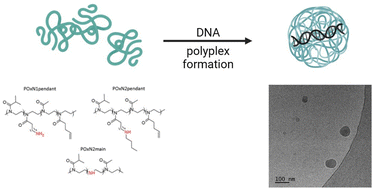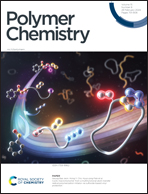Amino-modified 2-oxazoline copolymers for complexation with DNA†
Abstract
Copolymers of 2-isopropyl-2-oxazoline (iPrOx) with 2-methyl-2-oxazoline (MetOx) and 2-(3-butenyl)-2-oxazoline (ButEnOx) were synthesized via cationic ring opening polymerization (CROP). In the next step, the copolymers were modified to obtain primary and secondary amino groups in the substituents or in the main chain. Studies aimed to prove how the position of the amino groups in 2-oxazoline-derived copolymers influences their ability to condense DNA into so-called polyplexes. The post-polymerization modifications of the copolymers were done using hydrolysis and a thio-click reaction. The physicochemical characterization of the obtained copolymers and polyplexes was performed and then biological experiments followed to assess the cytotoxicity and transfection of the copolymers with secondary amino groups in the side chains. The results from differential scanning calorimetry (DSC) and wide-angle X-ray scattering (WAXS) have shown that the obtained copolymers did not contain a crystalline fraction, which makes it possible to apply them as nucleic acid carriers. The measurements of the sizes of the obtained polyplexes evidenced that the presence of primary amino groups in the substituent (POxN1pendant) impedes DNA binding, despite the positive zeta potential. On the other hand, the polymers with secondary amines, regardless the position (in the main chain for POxN2main or as a substituent in the case of POxN2pendant), form complexes with DNA to give nanostructures with smaller sizes than polymers with H2NR displaying a negative zeta potential in the studied range of N/P values (from 3 to 10). The biological experiments have shown that the copolymer with a HNR2 group in the pendant chain is nontoxic for HT-1080 cells in the range of concentrations from 5 to 100 μg mL−1 and is able to transfect those cells.

- This article is part of the themed collection: Polymers for Gene Delivery


 Please wait while we load your content...
Please wait while we load your content...